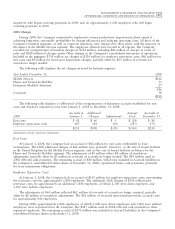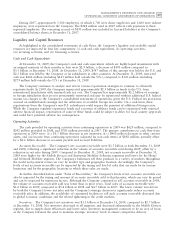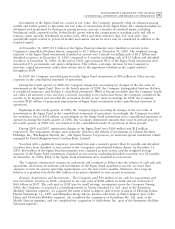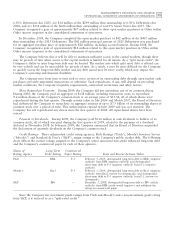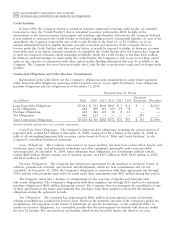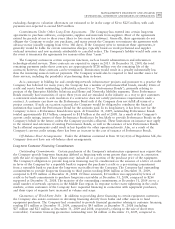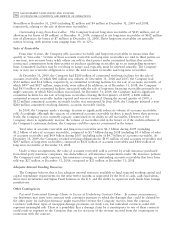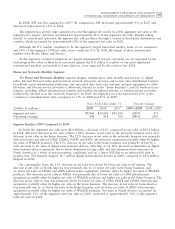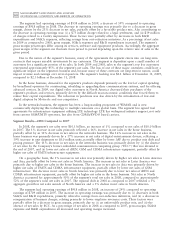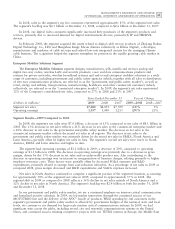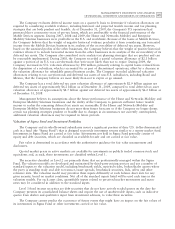Motorola 2009 Annual Report Download - page 64
Download and view the complete annual report
Please find page 64 of the 2009 Motorola annual report below. You can navigate through the pages in the report by either clicking on the pages listed below, or by using the keyword search tool below to find specific information within the annual report.
56 MANAGEMENT’S DISCUSSION AND ANALYSIS
OF FINANCIAL CONDITION AND RESULTS OF OPERATIONS
$6 million at December 31, 2008 (including $2 million and $4 million at December 31, 2009 and 2008,
respectively, relating to the sale of short-term receivables).
Outstanding Long-Term Receivables: The Company had net long-term receivables of $145 million, (net of
allowances for losses of $9 million) at December 31, 2009, compared to net long-term receivables of $162 million
(net of allowances for losses of $7 million) at December 31, 2008. These long-term receivables are generally
interest bearing, with interest rates ranging from 4% to 12%.
Sales of Receivables
From time to time, the Company sells accounts receivable and long-term receivables in transactions that
qualify as ‘‘true-sales.’’ Certain of these accounts receivable and long-term receivables are sold to third parties on
a one-time, non-recourse basis, while others are sold to third parties under committed facilities that involve
contractual commitments from these parties to purchase qualifying receivables up to an outstanding monetary
limit. Committed facilities may be revolving in nature and, typically, must be renewed annually. The Company
may or may not retain the obligation to service the sold accounts receivable and long-term receivables.
At December 31, 2009, the Company had $200 million of committed revolving facilities for the sale of
accounts receivable, of which $60 million was utilized. At December 31, 2008 and 2007, the Company had
$532 million and $1.4 billion, respectively, of committed revolving facilities for the sale of accounts receivable, of
which $497 and $817 million, respectively, were utilized. In addition, as of December 31, 2008, the Company
had $435 million of committed facilities associated with the sale of long-term financing receivables primarily for a
single customer, of which $262 million was utilized. At December 31, 2009, the Company had no significant
committed facilities for the sale of long-term receivables. During the first quarter of 2009, a $400 million
committed accounts receivable facility expired and was not renewed. During the second quarter of 2009, a
$132 million committed accounts receivable facility was terminated. In June 2009, the Company initiated a new
$200 million committed revolving domestic accounts receivable facility.
In 2009, the Company made a strategic decision to significantly reduce its volume of accounts receivables
sold. Accordingly, although the capacity of committed accounts receivable facilities is much lower than previous
levels, the Company is not currently capacity constrained in its ability to sell receivables. However, if the
Company elects to significantly increase the volume of receivables sold in the future or if the creditworthiness of
the Company’s customers declines, the Company could be capacity constrained in the future.
Total sales of accounts receivable and long-term receivables were $1.3 billion during 2009 (including
$1.2 billion of sales of accounts receivable), compared to $3.7 billion during 2008 (including $3.4 billion of sales
of accounts receivable) and $4.9 billion during 2007 (including sales of $4.7 billion of accounts receivable). At
December 31, 2009, the Company retained servicing obligations for $195 million of sold accounts receivables and
$297 million of long-term receivables, compared to $621 million of accounts receivables and $400 million of
long-term receivables at December 31, 2008.
Under certain arrangements, the value of accounts receivable sold is covered by credit insurance purchased
from third-party insurance companies, less deductibles or self-insurance requirements under the insurance policies.
The Company’s total credit exposure, less insurance coverage, to outstanding accounts receivables that have been
sold was $27 million at December 31, 2009, compared to $23 million at December 31, 2008.
Adequate Internal Funding Resources
The Company believes that it has adequate internal resources available to fund expected working capital and
capital expenditure requirements for the next twelve months as supported by the level of cash, cash equivalents,
short-term investments and Sigma Fund balances in the U.S. and the ability to repatriate such funds from foreign
jurisdictions.
Other Contingencies
Potential Contractual Damage Claims in Excess of Underlying Contract Value: In certain circumstances,
our businesses may enter into contracts with customers pursuant to which the damages that could be claimed by
the other party for failed performance might exceed the revenue the Company receives from the contract.
Contracts with these types of uncapped damage provisions are fairly rare, but individual contracts could still
represent meaningful risk. There is a possibility that a damage claim by a counterparty to one of these contracts
could result in expenses to the Company that are far in excess of the revenue received from the counterparty in
connection with the contract.



